This post may contain affiliate links. I only recommend products or services that I personally use or trust, promise!

Galchi jorim is one of my FAVORITE Korean dishes ever! It is a spicy, sweet, & savory dish with a hint of ocean flavor. The fish is braised with a delicious seasoning sauce, and makes the BEST radish!
I grew up eating this at home quite a bit. It is also one of my mom’s favorites. Unfortunately, I don’t get to make it that often now because my husband doesn’t like it very much. He can’t be bothered with all the bones- he hates eating fish around lots of bones.
You can use any white fish to make this, but belt fish is traditionally used for it. I personally prefer mackerel because it is easier to make, but my husband dislikes mackerel even more than belt fish. If you like mackerel, I recommend trying this recipe out with that first since it is less steps. Mackerel is a lot stronger in fishy flavor, but I love it!
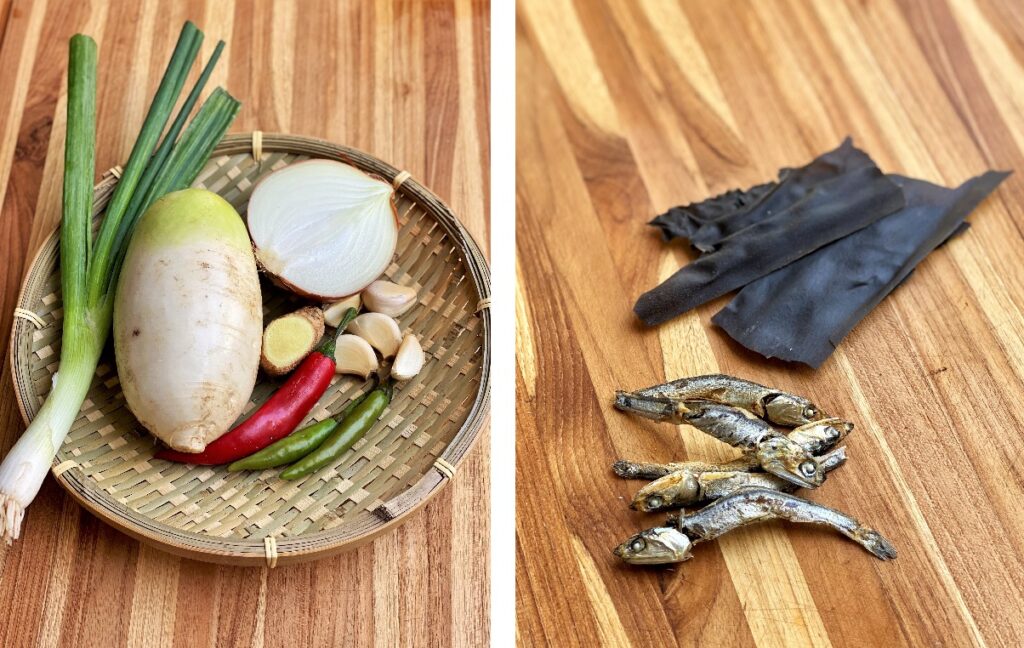
Ingredients
- Anchovy stock- this is optional but highly recommended. You can use water instead.
- Veggies- you will need Korean radish, a large green onion, sliced onions, and red & green peppers. I used the spicy Korean green pepper (cheongyang gochu), but you can use serrano. In my opinion, the Korean radish is NOT optional. It is a must in this recipe. 무조림 (braised radish) is the best part of this dish for me!
- Belt fish- Galchi is belt fish, which is mild with the hint of briny, ocean flavor. The meat is white and delicate, and has quite of bit of bones in it. When cooked correctly, this fish is amazing! You can usually find them fresh and already cut at Korean supermarkets. If you can’t find belt fish, you can also use mackerel. Mackerel is a lot stronger in flavor but it is still really good with this recipe.
- Seasoning sauce- the sauce is SO very important in this dish. You need to get it to just the right taste and consistency. One of the best parts of galchi jorim is spooning the sauce over your rice- the flavor is to die for! It’s sweet, spicy, savory, with a hint of ocean taste. The seasoning sauce ingredients are listed below, but I do want to address a few of them here: I use a mixture of coarse gochugaru and fine gochugaru. You can just use coarse if that’s all you have. I use fine powder because it retains more of its spiciness when braising, while the coarse gochugaru gives it more color. The fine powder also mixes better with liquids, so the end product is a really nice, deep red color that doesn’t show too many individual flakes (which also annoyingly gets stuck in your teeth). The plum & ginger cooking wine (맛술) is also important- this helps to get rid of the fishy smell from the beltfish and also adds some really nice complex flavors to the dish. If you can’t find it, you can use mirin instead.
- Rice water- when preparing your rice for this, save the rice water from rinsing. Rice water is great for removing fishy smells. We will be soaking cleaned beltfish in rice water for 30 minutes in the fridge.
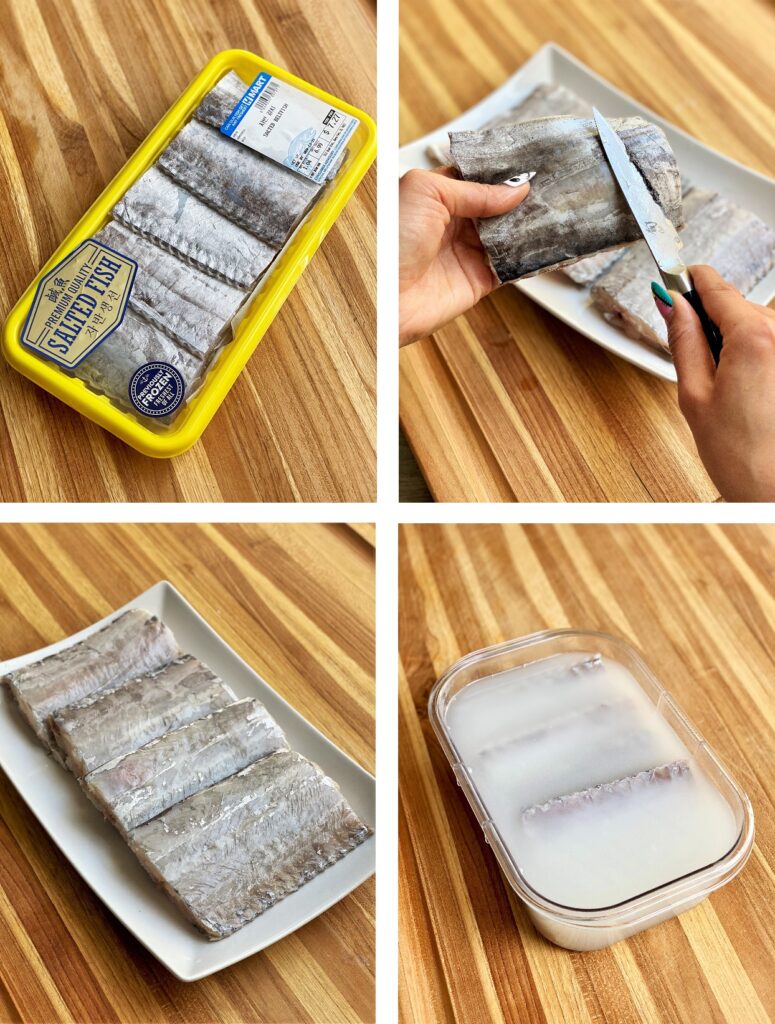
Prepping the belt fish
You should be able to find belt fish already cut in the fresh fish section at your local Korean market. Sometimes you have to go to the fish section and ask the fish mongers to clean and cut it for you.
Belt fish has a strong fishy smell to it that Koreans refer to as “bi-rin-neh” (비린내). Most of that smell is in the smooth silvery skin. You’ll need to remove the skin carefully by scraping it off with a knife.
If you’re not that sensitive to fishiness, you can just skip this step. A lot of restaurants do not remove the skin because it looks nicer that way. Instead, they take more measures to remove the smell by soaking in rice wine or a mixture of water and vinegar over night.
I am not that sensitive to fishiness so I personally don’t remove the skin when making it at home, but I did it for this recipe since most people would probably prefer it. You will also need to soak the fish in rice water to help remove some of the fishiness.
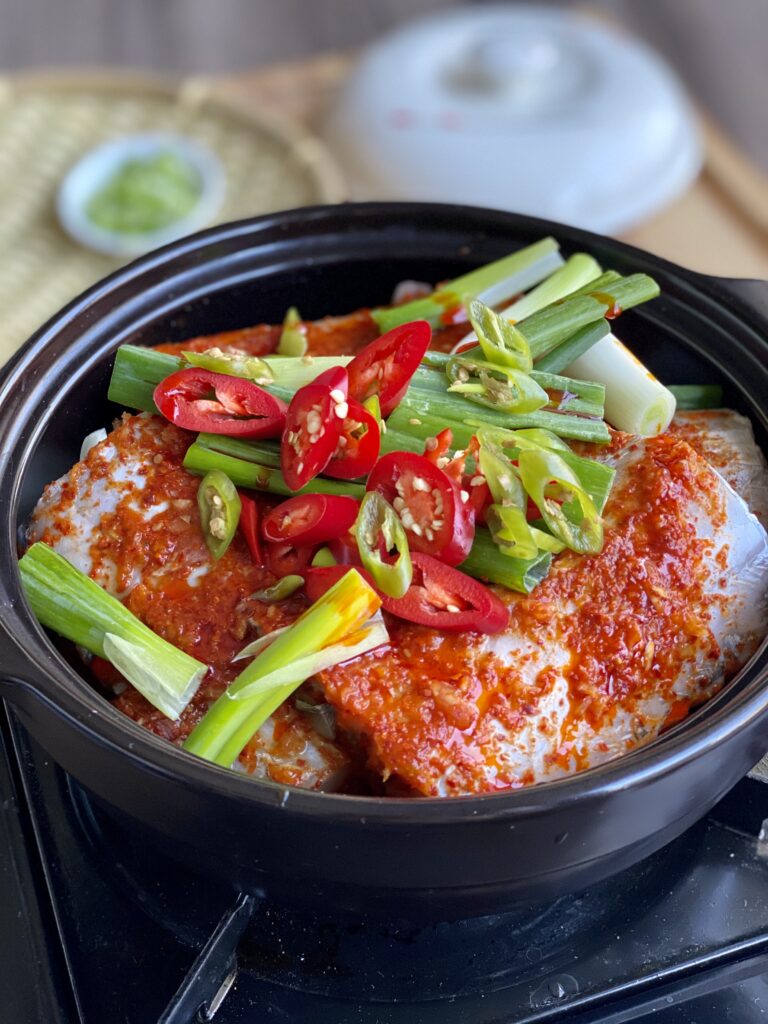
How to enjoy galchi jorim
Belt fish is slightly sweet, very delicate, and pairs well with rice and the braising sauce. My FAVORITE part is the radish! This braised radish is really something else. Korean radish also has a slightly sweet flavor, releasing a sweet liquid into the braising sauce that is just *chef’s kiss*.
Belt fish has quite a bit of bones that are comb-like and run down both sides of the fish. If you can locate the “spine” pieces of the bone, it is not difficult to pull them out in one swift motion. Otherwise, yes you will have to eat around the bones which can be a bit annoying.
I highly recommend spooning the braising sauce over your rice, and making each bite with rice, a piece of fish, and a piece of the radish. You may even find yourself reaching for just the radish at times- it is really, really good!
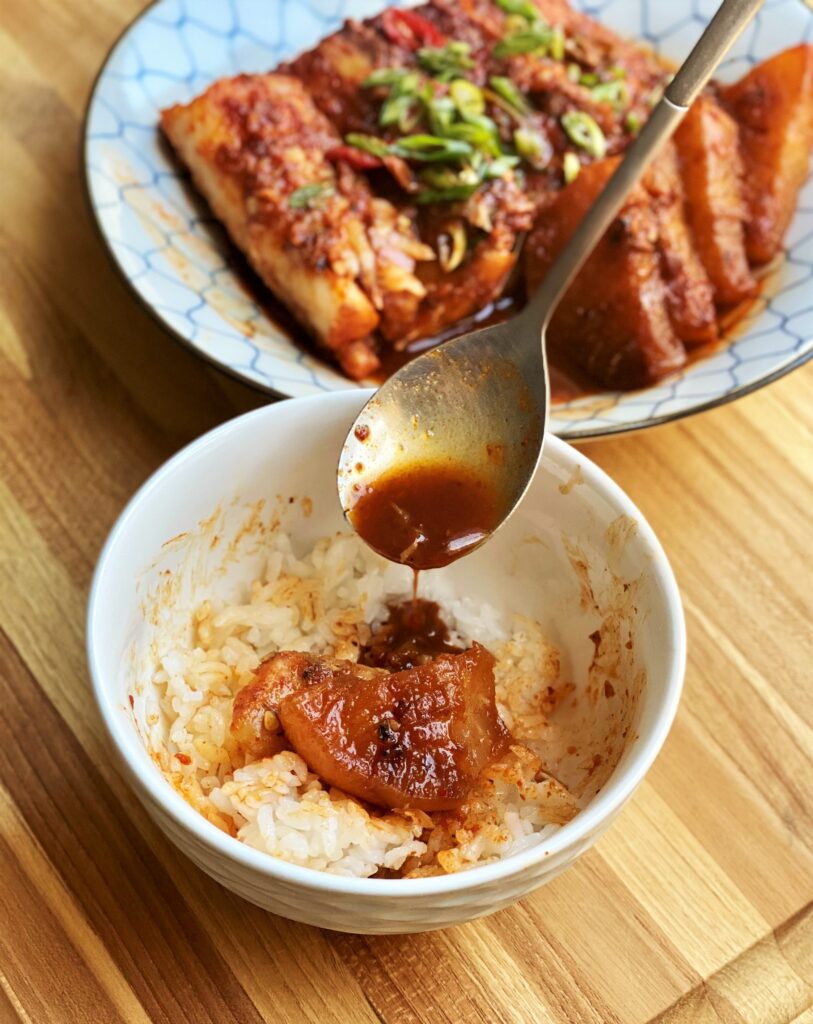
more seafood recipes

Galchi Jorim (Spicy Braised Beltfish)
Ingredients
- 1 lb beltfish, or mackerel
- 1/2 lb Korean radish
- 1/2 onion
- 1 large green onion (daepa)
- 2 serrano peppers sliced, or spicy Korean pepper
- 1 red pepper sliced
- 1/4 cup anchovy & kelp stock, or water
- 2 cups rice water, for soaking fish
- 1 tsp chili oil
Seasoning Sauce
- 2 tbsp soy sauce
- 2 tbsp coarse gochugaru, (Korean red pepper flakes)
- 1 tbsp fine gochugaru, (Korean red pepper flakes)
- 2 tbsp ginger & plum cooking wine (맛술), or mirin
- 1 tbsp sugar
- 1 tbsp plum syrup
- 1/2 tsp dwenjang, (Fermented soybean paste)
- 5 garlic cloves, crushed
- 1/2 tsp fresh ginger, crushed
- pinch of black pepper
Instructions
- If making the anchovy and kelp stock (highly recommended), boil about 1/2 cup of water with 1 oz of kelp and 3-4 medium dried anchovies for about 20 minutes. Or you can just use water instead.
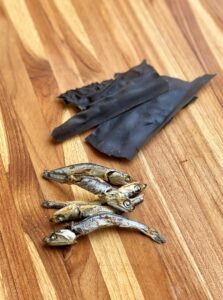
- The silver skin on the belt fish can give it a very strong fishy smell- remove the skin by carefully scraping it off with a knife. You don't have to remove all of it, just remove as much as you can without putting too much effort into it. In my opinion, the fishy smell is not too bad considering we are doing other things to combat it. A lot of restaurants leave it on because it looks better.
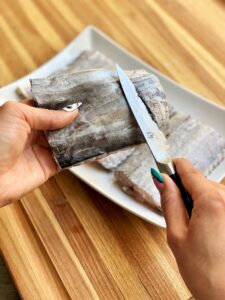
- Soak the belt fish in rice water for 30 minutes in the fridge. I always make a pot of rice to eat with galchi jorim, so just make sure to save your rice water when you are rinsing it. Rice water helps to remove the strong fishy smell.Note: if you are making this with mackerel, you can skip all the steps so far. Instead, just gut & clean your mackerel, remove the head, then cut into 2 inch steaks. The rest of the instructions are the same.
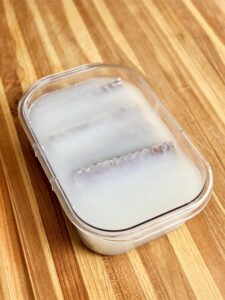
- Peel and cut the Korean radish into half moons. You want them to be about 1 cm thick.
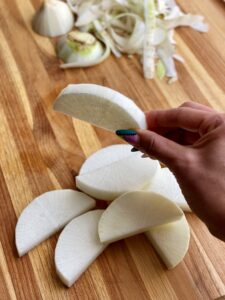
- Mix the seasoning sauce ingredients together. If you can't find the ginger and plum cooking wine, you can use mirin or an equal mixture of water and soju.
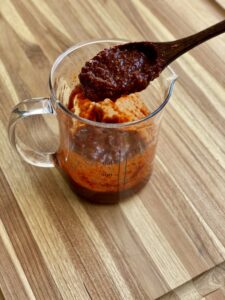
- Use a shallow, thick bottomed pot and arrange the Korean radish on the bottom. I always use the pattern pictured below to fit as much as possible (the Korean radish is my favorite part!).
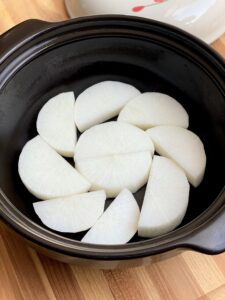
- Spread about 1/4 of the sauce over the Korean radish and pour all of the anchovy stock so the radish doesn't burn. Cover and cook on medium heat for about 5 minutes.

- Uncover then flip the radishes over
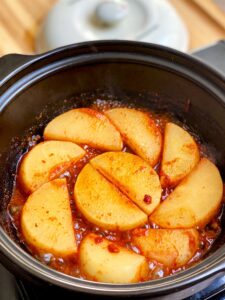
- Add the sliced onions on top
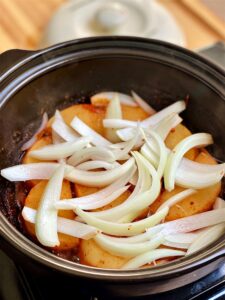
- Add the belt fish, then spread the rest of the seasoning sauce over the beltfish. Add 2 tbsp of water to the container to collect any leftover sauce, then pour into the pot. Add the large green onions & peppers on top, then drizzle over the chili oil.Note: if it seems like there isn't enough braising liquid, don't worry! Korean radishes hold a lot of water that will be released while cooking. The radish water is slightly sweet and adds some amazing depth and flavor to the braising sauce.

- Cover and cook on medium for 20 minutes, checking occasionally to spoon over the sauce and to make sure the radish doesn't burn at the bottom. After 20 minutes, turn the heat up to high for 3-4 minutes so the sauce thickens a bit.

- Enjoy with a bowl of rice. The perfect bite is rice with some fish, radish, and the braising sauce 🙂

Nutrition information is automatically calculated, so should only be used as an approximation.
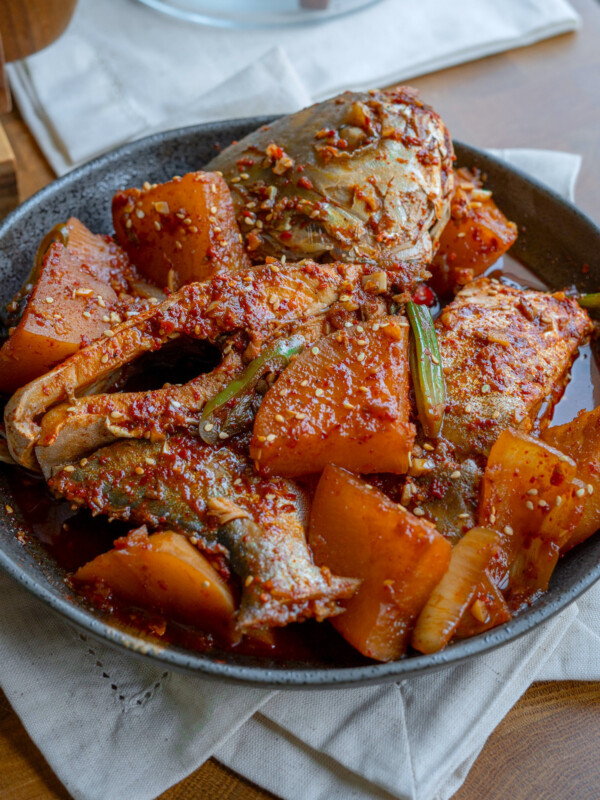
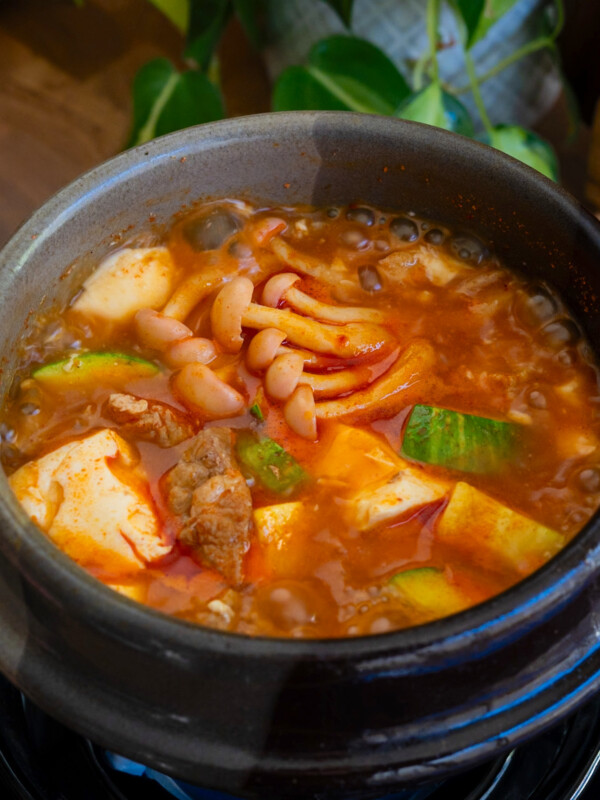

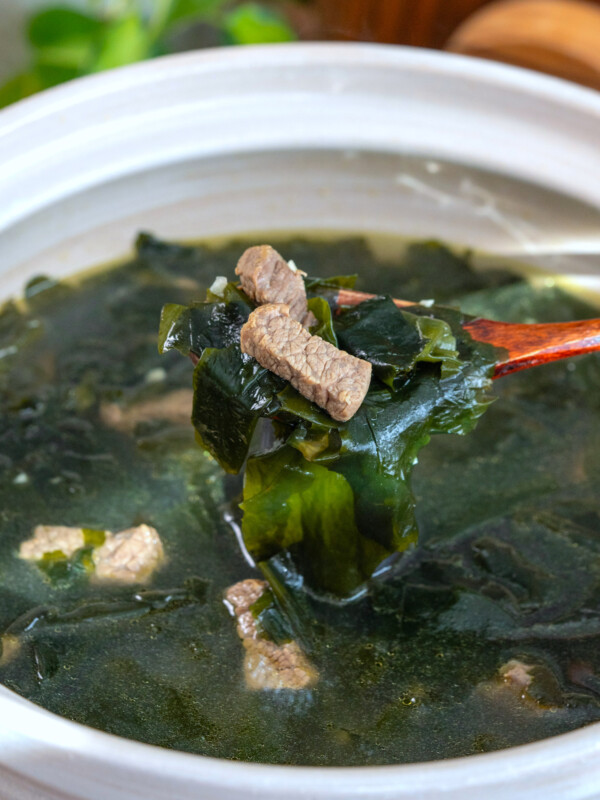
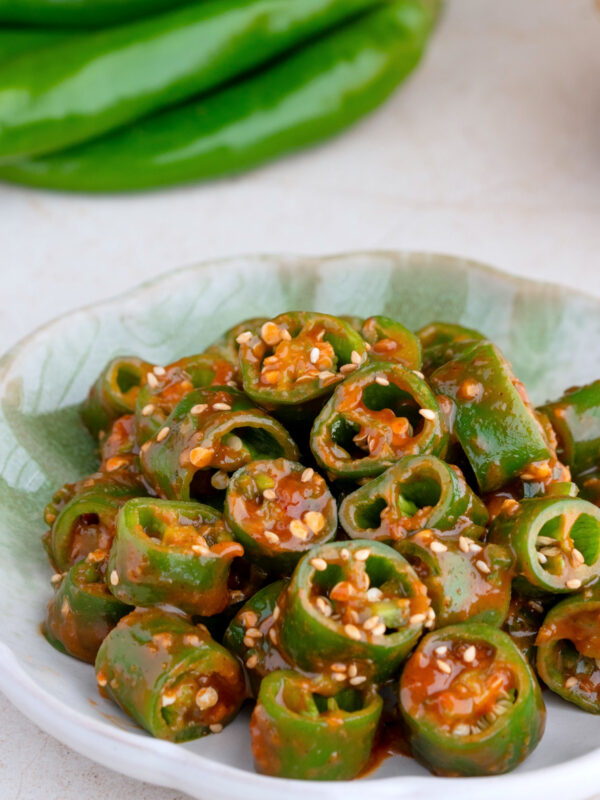

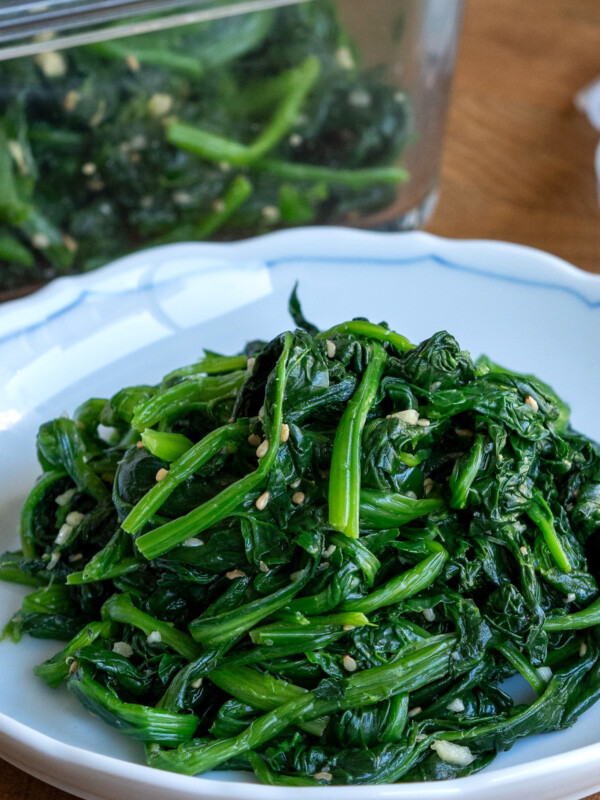
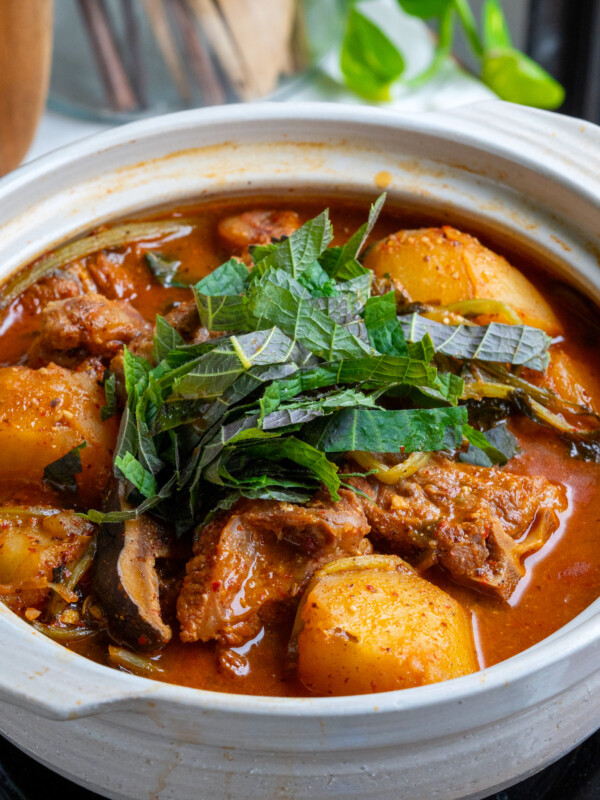







its my favourite i love ❤️❤️❤️❤️
Tastes just like my mothers recipe 🤎
Hi, ❤ Korean food. Have been trying to cook it. Love your recipe, when u say ginger &plum, is that fresh plum? Pls let me know, can’t wait to cook this. Thank you.
Hi Sona, it is not fresh plum but plum syrup or extract. It is similar to a sweetening syrup but also has tangy notes and has more complex flavors. You can find it at any Korean grocery store 🙂